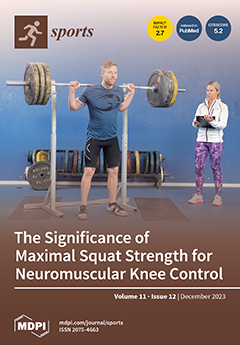The current study verified the acute responses of participants to a football match in terms of blood markers. Sixteen elite U-18 male football players were divided into two groups: experimental (EG,
n = 10), who played a friendly football match; and control (CG),
[...] Read more.
The current study verified the acute responses of participants to a football match in terms of blood markers. Sixteen elite U-18 male football players were divided into two groups: experimental (EG,
n = 10), who played a friendly football match; and control (CG), who were not exposed to any physical exertion. Intravenous blood samples were collected from both groups at baseline, pre-match, half-time, and post-match. The blood analysis consisted of four groups: immunological (leukocytes, platelets, and cortisol), muscle damage (creatine kinase and lactate dehydrogenase), metabolic (lactate, glucose, erythrocytes, hematocrit, hemoglobin, and urea), and electrolytic (sodium, calcium, and potassium). Edwards’ training impulse demonstrated that the first half was more demanding than the second half (
p = 0.020). Significant changes between time points and groups were observed for leukocytes (pre-match: 6920 ± 1949; post-match: 13,890 ± 3292;
p ≤ 0.05) and cortisol (pre-match: 10.78 ± 3.63; post-match: 19.15 ± 7.40;
p ≤ 0.05). CK (pre-match: 516.50 ± 248.38; post-match: 713.70 ± 308.20;
p ≤ 0.05) and LDH (pre-match: 348.80 ± 36.49; post-match: 414.80 ± 26.55;
p ≤ 0.05) increased significantly across the time points for the EG, with no difference between the groups, however. Raised lactate (pre-match: 1.05 ± 0.32; post-match: 3.24 ± 1.60;
p ≤ 0.05) and glucose (pre-match: 72.54 ± 9.76; post-match: 101.42 ± 19.87;
p ≤ 0.05) differences between the groups at half-time were also observed. These current findings provide helpful information to better understand football match demands regarding physiological effects.
Full article






